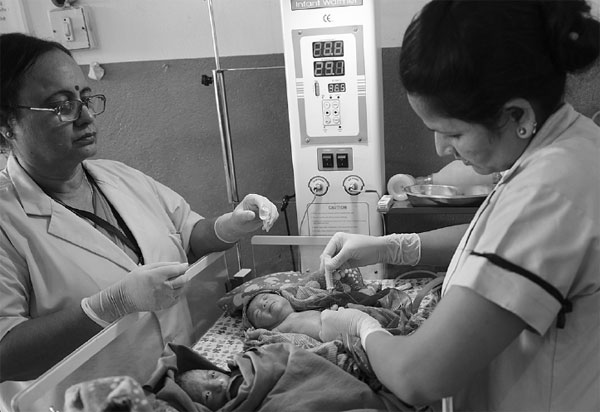Army of housewives saves Nepal's newborns
On a wet and windy morning, Nepalese housewife Bhumisara Upadhyay is out visiting pregnant women, on a mission to slash newborn deaths with a simple tube of gel.
Upadhyay is among thousands of volunteers on the front line of a campaign that has dramatically cut neonatal mortality in a country where nearly two-thirds of babies are born at home.
Health experts attribute Nepal's newborn mortality rate to infections contracted through the umbilical stump, which is traditionally coated with a mix of oil and turmeric after the cord is cut.
Instead, the volunteers persuade women to use a basic antiseptic gel that they distribute free of charge under an initiative launched three years ago with funding from the US development agency USAID.
Within a year of the launch, newborn deaths declined by a dramatic 27 percent, and organizers now plan to extend the program nationwide over the next three years.
"When I had my own children 20 to 25 years ago, babies would just die overnight, no one understood why. It was like living in a graveyard," Upadhyay, 42, said in her home village of Badalamji, perched on a ridge in the remote midwest of the country.
"We used to say it was good to have lots of babies, because half would die before they learned to talk."
Married before puberty to a man 22 years her senior, Upadhyay was just 17 when she gave birth to her first child after enduring eight days of labor. The baby girl survived, but many others are not as lucky.
Rambha Sharma, matron of Kohalpur Teaching Hospital in Midwestern Nepal, said, "People use dirty sickles to cut the cord and apply cowdung, turmeric and oil to the stump.
"Babies end up with life-threatening infections like neonatal tetanus thanks to these traditional practices."
The hospital pioneered the use of the antiseptic gel on infants. Chlorhexidine, a widely used disinfectant in developed countries, is the main ingredient, and the gel is distributed for free across 47 of Nepal's 75 districts. It is applied only once to the stump, and binds to the skin and dries in minutes.
Overturning tradition
The gel sounds like a simple solution, but overturning traditional practices has been a major challenge.
Leela Khanal of the US nonprofit organization John Snow Inc, which runs the program, said many members of Nepal's Muslim minority initially refused to use the gel.
"It took us months to convince them that it would protect, not harm, their children," she said.
The superstitions surrounding childbirth among some high-caste Hindu communities were another hurdle.
Each of the four times Upadhyay gave birth, she and the newborn were confined to an outhouse for 11 days until a priest arrived to "purify" mother and child.
"No one was allowed to touch me because of the taboo," she said. "I washed my own clothes, I had to eat from separate utensils, do everything for the baby myself."
Every morning, thousands of housewives like Upadhyay walk for hours, braving rain, extreme temperatures and the threat of landslides, to visit pregnant women scattered across Nepal's steep slopes.
The volunteers are community health workers, a network the government established in 1988 to promote family planning.
They teach pregnant women how to care for newborns, and hand out tubes of the gel so mothers can apply it themselves. It is a painstaking process, going from home to home, but one that is paying off.
|
A Nepalese health worker applies chlorhexidine to the umbilical cord of a newborn delivered at Kohalpur Teaching Hospital in Banke District, some 500 kilometers west of Kathmandu. Thousands of volunteers are helping to dramatically cut neonatal mortality in a country where nearly two-thirds of babies are born at home. Prakash Mathema / Agence France-Pressel |
(China Daily 11/19/2014 page11)















